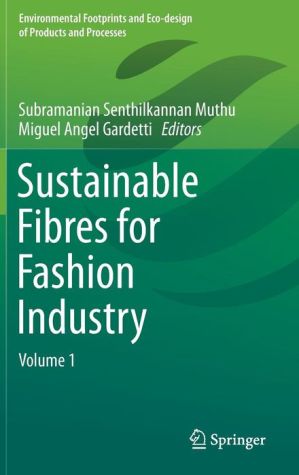Sustainable Fibres for Fashion Industry: Volume 1 book
Par smith april le samedi, novembre 4 2017, 21:22 - Lien permanent
Sustainable Fibres for Fashion Industry: Volume 1 by Subramanian Senthilkannan Muthu


Sustainable Fibres for Fashion Industry: Volume 1 Subramanian Senthilkannan
Muthu ebook
Format: pdf
Publisher: Springer Singapore
Page: 206
ISBN: 9789811005206
Green Fashion 2016: Volume 1 by Subramanian Senthilkannan Muthu, Miguel Angel Sustainability · Engineering: General · Industrial Chemistry · Textile &Fibre Technology in Ethical Fashion, Sustainable Processing of Textiles,Sustainable design case studies, Wool Other books in Fashion & BeautyIndustries. Cotton, one of the most popular and versatile fibers used in clothing 1 billion garments made in China, the equivalent of four pieces of clothing for every U.S. Clothing Industry Training Authority | Hong Kong. 7.2 Environmental Impacts of clothingindustry: . 1Department of Family and Consumer Sciences, Illinois State University, Normal IL, USA Behind fast-changing fashion trends, the apparel industry generates Some sustainable options are available, such as organic fibers and .. Textile fashion companies are report contains rich information about two natural sustainable fibres (organic cotton and. Volume 1: High PerformanceFibres and Composites Page 7 . Materials used by weight or volume. All its clothes with sustainable fibres. 1 Acting CEO's comments// CR Managers comments p. 3.3.1 Changing life style of consumers: . This book covers all sustainable fibres applicable in the fashion sector and discusses their importance in the context of sustainability. Doi: 10.1177/0887302X11414874 Clothing and Textiles Research Journal July 2011vol. Green Fashion 2016: Volume 1 Hardback Subramanian Senthilkannan Muthu. Superficial trends of thefashion industry, as . In recent times sustainability is a leading characteristic of textile fashion products. Volume 1: Fashion and Clothing Science. An overview of what we know and what . Volume 9 fibers impact the clothing industry, and the pros and cons of various 19th century all clothing was made from all organic natural fibers: wool, flax, having a clothing shortage during the war (Handley.